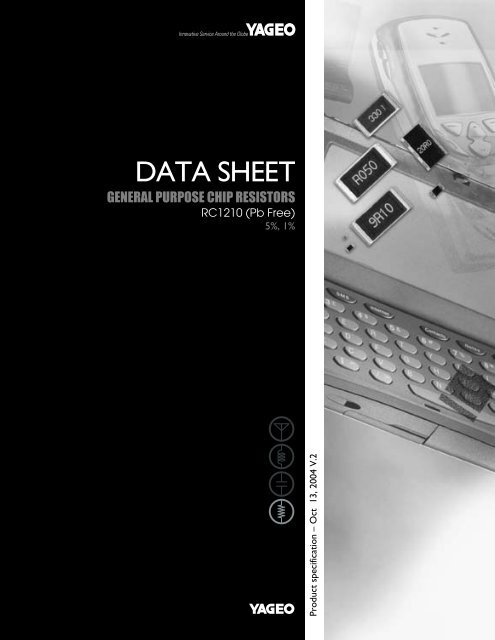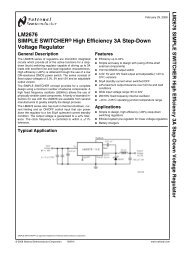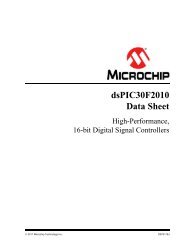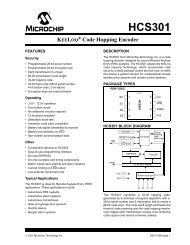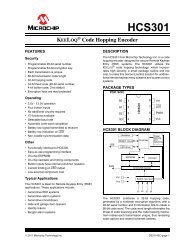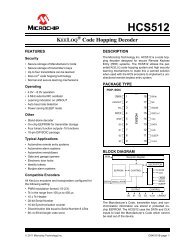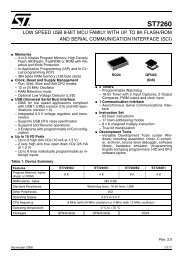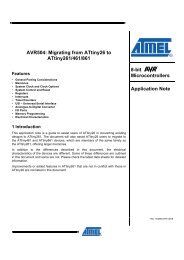DATA SHEET - Yageo
DATA SHEET - Yageo
DATA SHEET - Yageo
You also want an ePaper? Increase the reach of your titles
YUMPU automatically turns print PDFs into web optimized ePapers that Google loves.
<strong>DATA</strong> <strong>SHEET</strong><br />
GENERAL PURPOSE CHIP RESISTORS<br />
RC1210 (Pb Free)<br />
5%, 1%<br />
Product specification – Oct 13, 2004 V.2 Supersedes Date of Mar. 06, 2003
Chip Resistor Surface Mount<br />
RC<br />
SERIES<br />
1210 (Pb Free)<br />
Product specification<br />
2<br />
8<br />
SCOPE<br />
This specification describes RC1210 series chip resistors with lead-free terminations made by thick film process.<br />
ORDERING INFORMATION<br />
Part number is identified by the series, size, tolerance, packing type, temperature coefficient, taping reel and<br />
resistance value.<br />
YAGEO ORDERING CODE<br />
CTC CODE<br />
RC1210<br />
(1) TOLERANCE<br />
F = ±1%<br />
J = ±5%<br />
X X X XX XXXX L<br />
(1) (2) (3) (4) (5) (6)<br />
(2) PACKAGING TYPE<br />
R = Paper/PE taping reel<br />
(3) TEMPERATURE COEFFICIENT OF RESISTANCE<br />
– = Base on spec<br />
ORDERING EXAMPLE<br />
The ordering code of a RC1210 chip resistor, value<br />
56 X with ±1% tolerance, supplied in 7-inch tape reel<br />
is: RC1210FR-0756RL.<br />
NOTE<br />
1. The “L” at the end of the code is only for ordering. On the reel<br />
label, the standard CTC will be mentioned an additional stamp<br />
“LFP”= lead free production.<br />
2. Products with lead in terminations fulfil the same requirements<br />
as mentioned in this datasheet.<br />
3. Products with lead in terminations will be phased out in the<br />
coming months (before July 1st, 2006)<br />
(4) TAPING REEL<br />
07 = 7 inch dia. Reel<br />
13 = 13 inch dia. Reel<br />
(5) RESISTANCE VALUE<br />
5R6, 56R, 560R, 56K, 22M.<br />
(6) RESISTOR TERMINATIONS<br />
L = Lead free terminations (pure Tin)<br />
Oct 13, 2004 V.2<br />
www.yageo.com
ynsc001<br />
ynsc004<br />
Chip Resistor Surface Mount<br />
RC<br />
SERIES<br />
1210 (Pb Free)<br />
Product specification<br />
3<br />
8<br />
MARKING<br />
RC1210<br />
Fig. 1<br />
Value=10 KΩ<br />
E-24 series: 3 digits<br />
First two digits for significant figure and 3rd digit for number of zeros<br />
Fig. 2 Value=10 KΩ<br />
Both E-24 and E-96 series: 4 digits<br />
First three digits for significant figure and 4th digit for number of zeros<br />
For marking codes, please see EIA-marking code rules in data sheet “Chip resistors instruction”.<br />
CONSTRUCTION<br />
The resistors are constructed out of<br />
a high-grade ceramic body. Internal<br />
handbook, 4 columns<br />
metal electrodes are added at each<br />
end and connected by a resistive<br />
paste. The composition of the paste<br />
H<br />
is adjusted to give the approximate<br />
required resistance and laser cutting<br />
I 2<br />
of this resistive layer that achieves<br />
tolerance trims the value. The<br />
Fig. 3 Chip resistor construction<br />
resistive layer is covered with a<br />
protective coat and printed with the<br />
resistance value. Finally, the two external terminations (pure Tin) are added. See fig. 3.<br />
protective coat<br />
resistor layer<br />
inner electrode<br />
end termination<br />
ceramic substrate<br />
MBE940_a<br />
DIMENSIONS<br />
Table 1<br />
TYPE<br />
RC1210<br />
I 1<br />
protective coat<br />
L (mm) 3.10 ±0.10<br />
W (mm) 2.60 ±0.15<br />
H (mm) 0.50 ±0.10<br />
W<br />
I 1 (mm) 0.45 ±0.15<br />
I 2 (mm) 0.50 ±0.20<br />
MBE940_a<br />
L<br />
Fig. 4 Chip resistor dimension For dimension see Table 1<br />
Oct 13, 2004 V.2<br />
www.yageo.com
Chip Resistor Surface Mount<br />
RC<br />
SERIES<br />
1210 (Pb Free)<br />
Product specification<br />
4<br />
8<br />
ELECTRICAL CHARACTERISTICS<br />
Table 2<br />
CHARACTERISTICS<br />
RC1210 1/2 W<br />
Operating Temperature Range –55 °C to +155 °C<br />
Maximum Working Voltage<br />
200 V<br />
Maximum Overload Voltage<br />
500 V<br />
Dielectric Withstanding Voltage<br />
500 V<br />
5% (E24) 1 Ω to 22MΩ<br />
Resistance Range<br />
1% (E96) 1 Ω to 10 MΩ<br />
Zero Ohm Jumper < 0.05 Ω<br />
Temperature Coefficient<br />
10 Ω < R ≤ 10 MΩ ±100 ppm/°C<br />
R ≤ 10 Ω; R > 10 MΩ ±200 ppm/°C<br />
Jumper Criteria<br />
Rated Current<br />
2.0 A<br />
Maximum Current<br />
10.0 A<br />
FOOTPRINT AND SOLDERING<br />
PROFILES<br />
For recommended footprint and<br />
soldering profiles, please see the<br />
special data sheet “Chip resistors<br />
mounting”.<br />
ENVIRONMENTAL <strong>DATA</strong><br />
For material declaration<br />
information (IMDS-data) of the<br />
products, please see the<br />
separated info “Environmental<br />
data”.<br />
PACKING STYLE AND PACKAGING QUANTITY<br />
Table 3 Packing style and packaging quantity<br />
PRODUCT TYPE PACKING STYLE REEL DIMENSION QUANTITY PER REEL<br />
RC1210 Paper / PE Taping Reel (R) 7" (178 mm) 5,000 units<br />
13" (330 mm) 20,000 units<br />
NOTE<br />
1. For Paper/PE tape and reel specification/dimensions, please see the special data sheet “Packing” document.<br />
FUNCTIONAL DESCRIPTION<br />
POWER RATING<br />
RC1210 rated power at 70°C is 1/2 W<br />
RATED VOLTAGE<br />
The DC or AC (rms) continuous working voltage<br />
corresponding to the rated power is determined by<br />
the following formula:<br />
V=√(P X R)<br />
Where<br />
V=Continuous rated DC or<br />
AC (rms) working voltage (V)<br />
P=Rated power (W)<br />
R=Resistance value (X)<br />
Fig. 5<br />
P max<br />
(%P rated )<br />
100<br />
50<br />
MRA632<br />
0<br />
−55 0 50 70 100 155<br />
T amb (°C)<br />
Maximum dissipation (P max ) in percentage of rated power<br />
as a function of the operating ambient temperature (T amb )<br />
Oct 13, 2004 V.2<br />
www.yageo.com
Chip Resistor Surface Mount<br />
RC<br />
SERIES<br />
1210 (Pb Free)<br />
Product specification<br />
5<br />
8<br />
TESTS AND REQUIREMENTS<br />
Table 4 Test condition, procedure and requirements<br />
TEST TEST METHOD PROCEDURE REQUIREMENTS<br />
Temperature MIL-STD-202F-method 304; At +25/–55 °C and +25/+125 °C<br />
Refer to table 2<br />
Coefficient of JIS C 5202-4.8<br />
Resistance<br />
Formula:<br />
(T.C.R.)<br />
R<br />
T.C.R= ------------------------- 2 –R 1<br />
×10 6 (ppm/°C)<br />
R 1 (t 2 –t 1 )<br />
Where<br />
t 1 =+25 °C or specified room temperature<br />
t 2 =–55 °C or +125 °C test temperature<br />
R 1 =resistance at reference temperature in ohms<br />
R 2 =resistance at test temperature in ohms<br />
Thermal Shock MIL-STD-202F-method 107G;<br />
IEC 60115-1 4.19<br />
At –65 (+0/–10) °C for 2 minutes and at +155<br />
(+10/–0) °C for 2 minutes; 25 cycles<br />
±(0.5%+0.05 Ω) for 1% tol.<br />
±(1.0%+0.05 Ω) for 5% tol.<br />
Low<br />
Temperature<br />
Operation<br />
MIL-R-55342D-Para 4.7.4<br />
At –65 (+0/–5) °C for 1 hour; RCWV applied<br />
for 45 (+5/–0) minutes<br />
±(0.5%+0.05 Ω) for 1% tol .<br />
±(1.0%+0.05 Ω) for 5% tol.<br />
No visible damage<br />
Short Time<br />
Overload<br />
MIL-R-55342D-Para 4.7.5;<br />
IEC 60115-1 4.13<br />
2.5 × RCWV applied for 5 seconds at room<br />
temperature<br />
±(1.0%+0.05 Ω) for 1% tol.<br />
±(2.0%+0.05 Ω) for 5% tol.<br />
No visible damage<br />
Insulation<br />
Resistance<br />
MIL-STD-202F-method 302;<br />
IEC 60115-1 4.6.1.1<br />
RCOV for 1 minute<br />
Type<br />
RC1210<br />
≥10 GΩ<br />
Voltage (DC)<br />
500 V<br />
Dielectric<br />
Withstand<br />
Voltage<br />
MIL-STD-202F-method 301;<br />
IEC 60115-1 4.6.1.1<br />
No breakdown or flashover<br />
Maximum voltage (V rms ) applied for 1 minute<br />
Voltage (AC) 500 V rms<br />
Type<br />
RC1210<br />
Resistance to<br />
Soldering<br />
Heat<br />
MIL-STD-202F-method 210C;<br />
IEC 60115-1 4.18<br />
Unmounted chips; 260 ±5 °C for 10 ±1<br />
seconds<br />
±(0.5%+0.05 Ω) for 1% tol.<br />
±(1.0%+0.05 Ω) for 5% tol.<br />
No visible damage<br />
Life MIL-STD-202F-method 108A;<br />
IEC 60115-1 4.25.1<br />
At 70±2 °C for 1,000 hours; RCWV applied for<br />
1.5 hours on and 0.5 hour off<br />
±(1%+0.05 Ω) for 1% tol.<br />
±(3%+0.05 Ω) for 5% tol.<br />
Oct 13, 2004 V.2<br />
www.yageo.com
Chip Resistor Surface Mount<br />
RC<br />
SERIES<br />
1210 (Pb Free)<br />
Product specification<br />
6<br />
8<br />
TEST TEST METHOD PROCEDURE REQUIREMENTS<br />
Solderability MIL-STD-202F-method 208A; Solder bath at 245±3 °C<br />
Well tinned (≥95% covered)<br />
IEC 60115-1 4.17<br />
Dipping time: 2±0.5 seconds<br />
No visible damage<br />
Bending<br />
Strength<br />
JIS C 5202.6.14;<br />
IEC 60115-1 4.15<br />
Resistors mounted on a 90 mm glass epoxy<br />
resin PCB (FR4)<br />
±(1.0%+0.05 Ω) for 1% tol.<br />
±(1.0%+0.05 Ω) for 5% tol.<br />
Bending: 2 mm<br />
No visible damage<br />
Resistance to<br />
Solvent<br />
MIL-STD-202F-method 215;<br />
IEC 60115-1 4.29<br />
lsopropylalcohol (C 3 H 7 OH) or dichloromethane<br />
(CH 2 Cl 2 ) followed by brushing<br />
No smeared<br />
Noise JIS C 5202 5.9;<br />
IEC 60115-1 4.12<br />
Maximum voltage (V rms ) applied. Resistors range Value<br />
R < 100 Ω<br />
10 dB<br />
100 Ω ≤ R < 1 KΩ 24 dB<br />
1 KΩ ≤ R < 10 KΩ 34 dB<br />
10 KΩ ≤ R < 100 KΩ 44 dB<br />
100 KΩ ≤ R < 1 MΩ 46 dB<br />
1 MΩ ≤ R ≤ 22 MΩ 48 dB<br />
Humidity<br />
(steady state)<br />
JIS C 5202 7.5;<br />
IEC 60115-8 4.24.8<br />
1,000 hours; 40±2 °C; 93(+2/–3)% RH<br />
RCWV applied for 1.5 hours on and 0.5 hour off<br />
±(0.5%+0.05 Ω) for 1% tol.<br />
±(2.0%+0.05 Ω) for 5% tol.<br />
Leaching<br />
EIA/IS 4.13B;<br />
Solder bath at 260±5 °C<br />
No visible damage<br />
IEC 60115-8 4.18<br />
Dipping time: 30±1 seconds<br />
Intermittent<br />
Overload<br />
JIS C 5202 5.8<br />
At room temperature; 2.5 × RCWV applied for<br />
1 second on and 25 seconds off; total 10,000<br />
cycles<br />
±(1.0%+0.05 Ω) for 1% tol.<br />
±(2.0%+0.05 Ω) for 5% tol.<br />
Resistance to<br />
Vibration<br />
On request<br />
On request<br />
Moisture<br />
Resistance<br />
Heat<br />
MIL-STD-202F-method 106F;<br />
IEC 60115-1 4.24.2<br />
42 cycles; total 1,000 hours<br />
Shown as Fig. 6<br />
±(0.5%+0.05Ω) for 1% tol.<br />
±(2.0%+0.05Ω) for 5% tol.<br />
No visible damage<br />
www.yageo.com<br />
Oct 13, 2004 V.2
Chip Resistor Surface Mount<br />
RC<br />
SERIES<br />
1210 (Pb Free)<br />
Product specification<br />
7<br />
8<br />
temperature<br />
[°C]<br />
75<br />
50<br />
25<br />
0<br />
initial drying<br />
24 hours<br />
initial measurements<br />
as specified in 2.2<br />
temperature<br />
tolerance<br />
±2 °C (±3.6 °F)<br />
unless otherwise<br />
specified<br />
90 − 98% RH<br />
80 − 98%<br />
RH<br />
rate of change of temperature is unspecified,<br />
however, specimens shall not be subjected to<br />
radiant heating from chamber conditioning processes<br />
circulation of conditioning air shall be at a<br />
minimum cubic rate per minute equivalent to<br />
10 times the volume of the chamber<br />
voltage applied as specified in 2.4<br />
80 − 98%<br />
90 − 98% RH RH<br />
90 − 98% RH<br />
+10 °C (+18 °F)<br />
−2 °C (−3.6 °F)<br />
end of final cycle;<br />
measurements<br />
as specified in 2.7<br />
optional sub-cycle if specified<br />
(2.3); sub-cycle performed during<br />
any 5 of the first 9 cycles; humidity<br />
uncontrolled during sub-cycle<br />
prior to first<br />
cycle only<br />
STEP1<br />
STEP2<br />
STEP3 STEP4 STEP5 STEP6<br />
one cycle 24 hours; repeat as specified in 2.5<br />
STEP7<br />
HBK073<br />
0<br />
5 10 15<br />
20<br />
time [h]<br />
25<br />
Fig. 6 Moisture resistance test requirements<br />
Oct 13, 2004 V.2<br />
www.yageo.com
Chip Resistor Surface Mount<br />
RC<br />
SERIES<br />
1210 (Pb Free)<br />
Product specification<br />
8<br />
8<br />
REVISION HISTORY<br />
REVISION DATE CHANGE NOTIFICATION DESCRIPTION<br />
Version 2 Oct 13, 2004 - - Test method and procedure updated<br />
Oct 13, 2004 V.2<br />
www.yageo.com


